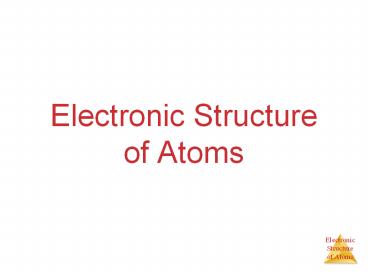Electronic Structure of Atoms - PowerPoint PPT Presentation
Title:
Electronic Structure of Atoms
Description:
Title: Chapter 6 Electronic Structure of Atoms Author: John Bookstaver Last modified by: CCS Created Date: 2/19/2005 9:01:38 PM Document presentation format – PowerPoint PPT presentation
Number of Views:188
Avg rating:3.0/5.0
Title: Electronic Structure of Atoms
1
Electronic Structureof Atoms
2
Waves
- To understand the electronic structure of atoms,
one must understand the nature of electromagnetic
radiation. - The distance between corresponding points on
adjacent waves is the wavelength (?).
3
Waves
- The number of waves passing a given point per
unit of time is the frequency (?). - For waves traveling at the same velocity, the
longer the wavelength, the smaller the frequency.
4
Electromagnetic Radiation
- All electromagnetic radiation travels at the same
velocity the speed of light (c), 3.00 ? 108
m/s. - Therefore,
- c ??
5
The Nature of Energy
- The wave nature of light does not explain how an
object can glow when its temperature increases. - Max Planck explained it by assuming that energy
comes in packets called quanta.
6
The Nature of Energy
- Einstein used this assumption to explain the
photoelectric effect. - He concluded that energy is proportional to
frequency - E h?
- where h is Plancks constant, 6.63 ? 10-34 J-s.
7
The Nature of Energy
- Therefore, if one knows the wavelength of light,
one can calculate the energy in one photon, or
packet, of that light - c ??
- E h?
8
The Nature of Energy
- Another mystery involved the emission spectra
observed from energy emitted by atoms and
molecules.
9
The Nature of Energy
- One does not observe a continuous spectrum, as
one gets from a white light source. - Only a line spectrum of discrete wavelengths is
observed.
10
The Nature of Energy
- Niels Bohr adopted Plancks assumption and
explained these phenomena in this way - Electrons in an atom can only occupy certain
orbits (corresponding to certain energies).
11
The Nature of Energy
- Niels Bohr adopted Plancks assumption and
explained these phenomena in this way - Electrons in permitted orbits have specific,
allowed energies these energies will not be
radiated from the atom.
12
The Nature of Energy
- Niels Bohr adopted Plancks assumption and
explained these phenomena in this way - Energy is only absorbed or emitted in such a way
as to move an electron from one allowed energy
state to another the energy is defined by - E h?
13
The Wave Nature of Matter
- Louis de Broglie posited that if light can have
material properties, matter should exhibit wave
properties. - He demonstrated that the relationship between
mass and wavelength was
14
The Uncertainty Principle
- Heisenberg showed that the more precisely the
momentum of a particle is known, the less
precisely is its position known - In many cases, our uncertainty of the whereabouts
of an electron is greater than the size of the
atom itself!
15
Quantum Mechanics
- Erwin Schrödinger developed a mathematical
treatment into which both the wave and particle
nature of matter could be incorporated. - It is known as quantum mechanics.
16
Energies of Orbitals
- For a one-electron hydrogen atom, orbitals on the
same energy level have the same energy. - That is, they are degenerate.
17
Pauli Exclusion Principle
- No two electrons in the same atom can have
exactly the same energy. - For example, no two electrons in the same atom
can have identical sets of quantum numbers.
18
Electron Configurations
- Distribution of all electrons in an atom
- Consist of
- Number denoting the energy level
19
Electron Configurations
- Distribution of all electrons in an atom
- Consist of
- Number denoting the energy level
- Letter denoting the type of orbital
20
Electron Configurations
- Distribution of all electrons in an atom.
- Consist of
- Number denoting the energy level.
- Letter denoting the type of orbital.
- Superscript denoting the number of electrons in
those orbitals.
21
Orbital Diagrams
- Each box represents one orbital.
- Half-arrows represent the electrons.
- The direction of the arrow represents the spin of
the electron.
22
Hunds Rule
- For degenerate orbitals, the lowest energy is
attained when the number of electrons with the
same spin is maximized.
23
Periodic Table
- We fill orbitals in increasing order of energy.
- Different blocks on the periodic table, then
correspond to different types of orbitals.
24
Some Anomalies
- Some irregularities occur when there are enough
electrons to half-fill s and d orbitals on a
given row.
25
Some Anomalies
- For instance, the electron configuration for
copper is - Ar 4s1 3d5
- rather than the expected
- Ar 4s2 3d4.
26
Some Anomalies
- This occurs because the 4s and 3d orbitals are
very close in energy. - These anomalies occur in f-block atoms, as well.
27
Paramagnetic and Diamagnetic
- Subshells are not completely filled
- Example
- He
- Be
- Li
- N
- Li and N are Paramagnetic
- He and Be are Diamagnetic
28
Isoelectric
- Having the same electron configuration
- Examples
- Lithium ion and Helium Atom
- Strontium ion and Rubidium Ion and Krypton































